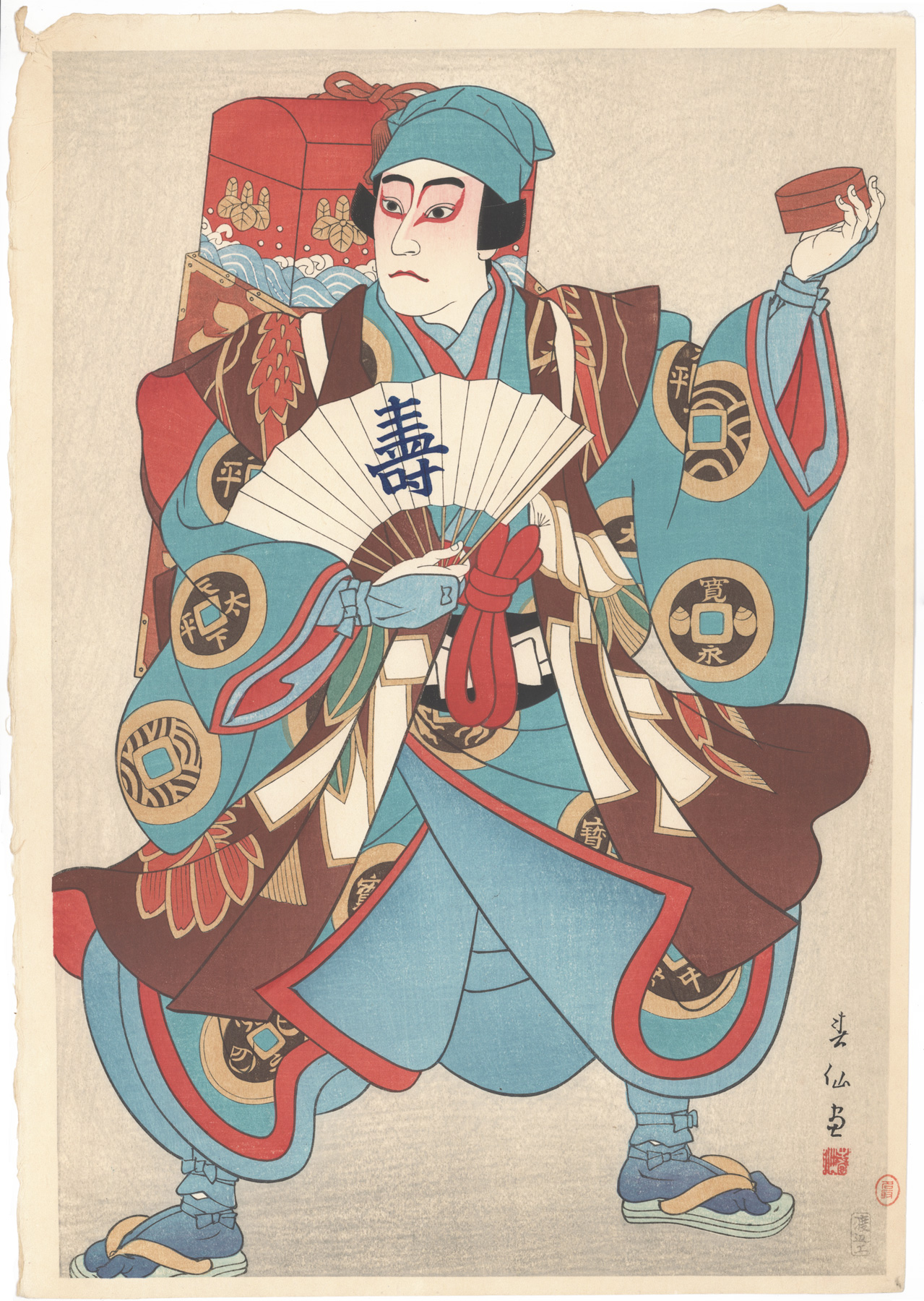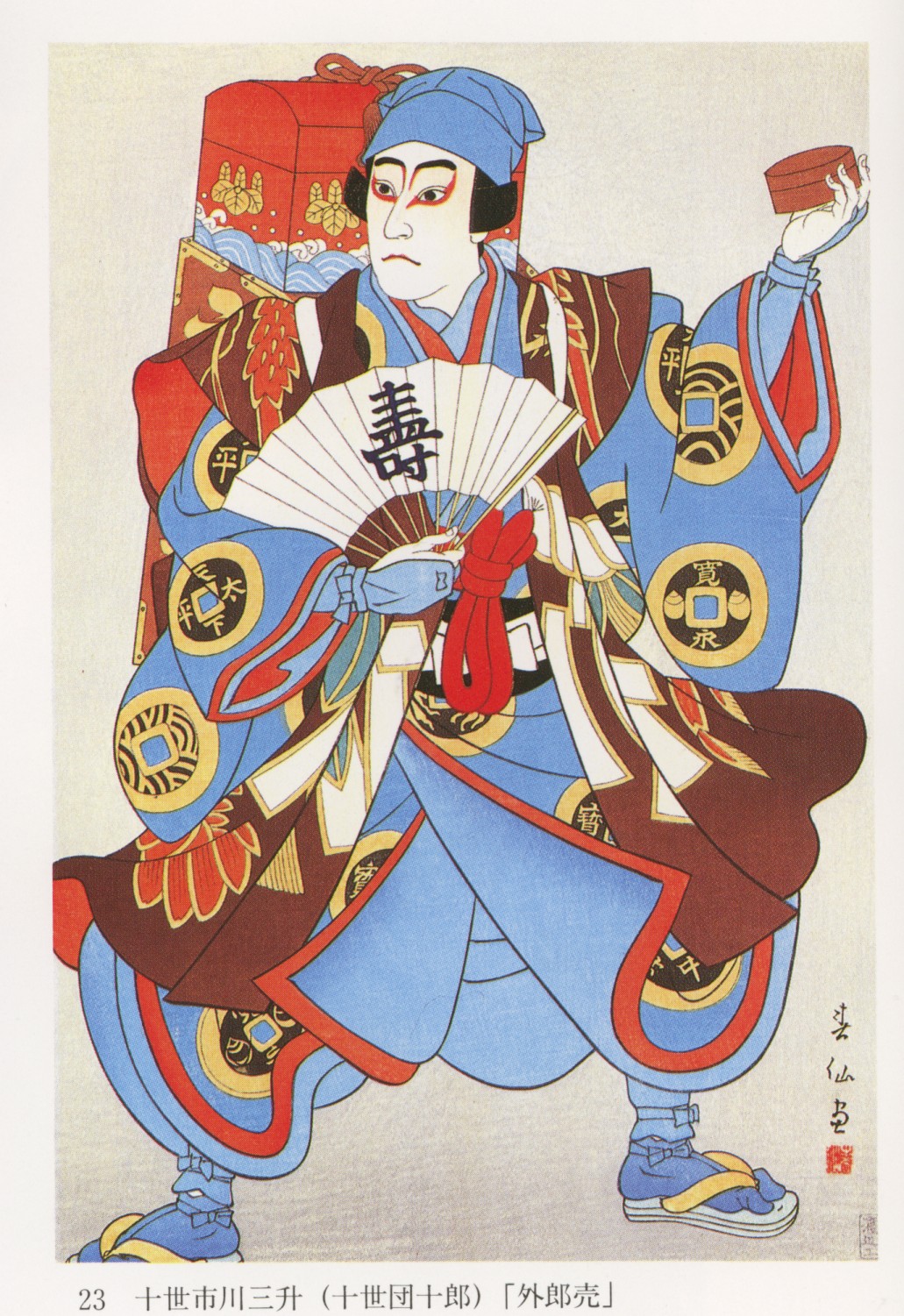One of thirty-six prints making up the Watanabe-published series Creative Print Collection of Portraits by Shunsen* (1925-1929). This print is the series installment no. 15. Along with the print Morita Kanya XIII As Genta Kagesue, one of two prints from this series in this collection. The character 壽 kotobuki (long life) is written on the actor's fan and refers to the medicine he is peddling.
* title of the series is given as 創作版画 春仙似顔集 in Ukiyoe Kabuki Gi Han Ga: Shunsen Natori which is a catalog raisonne of the artist's work.
Source: Dramatic Impressions: Japanese Theatre Prints from the Gilbert Luber Collection, Chance, Frank L. & Davis, Julie Nelson, University of Pennsylvania Press, 200, p. 41
Ichikawa Sanshō V* appears full-figure, early in his career, in a pose established long before for the role of the fast-talking peddler. Bearing on his back a pack full of moxa – Japanese mogusa, a medicine to be burned, like incense, on the skin of the patient – Sanshō faces the audience and holds out a sample as he delivers a long sales pitch filled with puns, jokes, and other remarks. The print and the pose reflect the long tradition of kabuki: this pose was struck, after all, in the first performance of the role, in 1716, by the second Danjūrō (1688–1758), and had since been pictured repeatedly in prints.
Ichikawa Sanshō V* appears full-figure, early in his career, in a pose established long before for the role of the fast-talking peddler. Bearing on his back a pack full of moxa – Japanese mogusa, a medicine to be burned, like incense, on the skin of the patient – Sanshō faces the audience and holds out a sample as he delivers a long sales pitch filled with puns, jokes, and other remarks. The print and the pose reflect the long tradition of kabuki: this pose was struck, after all, in the first performance of the role, in 1716, by the second Danjūrō (1688–1758), and had since been pictured repeatedly in prints.
* the text in Dramatic Impressions reads Ichikawa Sanshō X which is in error.
The Series Collection of Portraits by Shunsen (Collection of Creative Print Portraits by Shunsen)
Source: Dramatic Impressions: Japanese Theatre Prints from the Gilbert Luber Collection, Chance, Frank L. & Davis, Julie Nelson, University of Pennsylvania Press, 2007, p. 38-39 and Printed to Perfection: Twentieth-century Japanese Prints from the Robert O. Muller Collection, Merviss, Newland, et. al., Hotei Publishing, 2004, p. 88.
The result of the [Watanabe-Shunsen] collaboration was a series called Shunsen nigao shū [Collection of Portraits by Shunsen], sometimes translated as Portraits of Actors in Various Roles, produced between 1925 and 1929. Watanabe’s artisans were at this time at the peak of their skills, producing blocks with pristine, clear lines, and inking them in brilliant colors that reflect the evolution of tonalities to a modern vibrancy. They were issued in a special paper folder, listing the names of the actors and their roles. The series was extended by 15 more prints between 1929 and 1934.
The result of the [Watanabe-Shunsen] collaboration was a series called Shunsen nigao shū [Collection of Portraits by Shunsen], sometimes translated as Portraits of Actors in Various Roles, produced between 1925 and 1929. Watanabe’s artisans were at this time at the peak of their skills, producing blocks with pristine, clear lines, and inking them in brilliant colors that reflect the evolution of tonalities to a modern vibrancy. They were issued in a special paper folder, listing the names of the actors and their roles. The series was extended by 15 more prints between 1929 and 1934.
Catalogue Entry from The Toledo Art Museum Show 1930
One of thirty-six prints by Shunsen that were shown in the first shin hanga exhibition at the Toledo Museum of Art in 1930.
Source: Modern Japanese Prints, Dorothy Blair,The Toledo Art Museum 1997 (Printed from a photographic reproduction of two exhibition catalogues of modern Japanese prints published by The Toledo Museum of Art in 1930 and 1936)Actor in over coast of grey-blue with light blue lining, red border on cord, and brown-yellow Chinese “cash” motifs. Red-brown scarf with a red lining and with pattern of rice paper strips called gohei, and rope in red, green, yellow and white; cap, leggings and armlets, grey-blue; socks, blue-purple shaded to blue; light green sandals with grayed yellow straps. On fan, blue character “Kotobuki” (longevity); red-orange box; peddler’s cases, red and orange with blue and white wave motif and grayed yellow crest; lower case, strapped with grayed yellow. Background is light gray.
Signed “Shunsen ga” (Shunsen drawing); also his seal. Imprint of Watanabe, publisher. Margin:“Natori”, artist’s stamp of approval. Edition, 150 impressions; issued in 1926. 14 11/16” x 10 1/16”.
He died the 1st of February 1956. He posthumously received the name of Ichikawa Danjūrō X in 1962.
Signed “Shunsen ga” (Shunsen drawing); also his seal. Imprint of Watanabe, publisher. Margin:“Natori”, artist’s stamp of approval. Edition, 150 impressions; issued in 1926. 14 11/16” x 10 1/16”.
The Actor in the Print: Ichikawa Sanshō V (posthumously Ichikawa Danjūrō X) (1882–1956)
Source: Dramatic Impressions: Japanese Theatre Prints from the Gilbert Luber Collection, Chance, Frank L. & Davis, Julie Nelson, University of Pennsylvania Press, 200, p. 41.
Ichikawa Sanshō V*, is arguably the most important actor in the rough aragoto tradition. Sanshō was an unusual figure in modern kabuki, adopted from a non-acting family when he married the daughter of Ichikawa Danjūrō IX (1838 – 1903), inheritor of the most important lineage of kabuki actors. On the death of his father-in-law, Sanshō began to appear onstage, though he never took the Danjūrō stage name.
He died the 1st of February 1956. He posthumously received the name of Ichikawa Danjūrō X in 1962.
* the text in Dramatic Impressions reads Ichikawa Sanshō X which is in error.
"Uirō Uri" was not at the beginning a drama but a short scene, which was staged for the first time in January 1718 at the Moritaza, within Chikamatsu Genzaburō's new year drama "Wakamidori Ikioi Soga". It starred Ichikawa Danjūrō II in the role of a moxa peddler, in reality Soga Gorō Tokimune in disguise.
It was staged for the first time as an independent drama, which was titled "Uirō", in September 1922 at the Imperial Theater, starring Ichikawa Sanshō V in the role of Soga Gorō Tokimune.
This is one of many plays based on the revenge by the Soga brothers on Kudō Saemon Suketsune, the villain who was responsible for the murder of their father. In this particular play, this dramatic fight is transformed into light fantasy by showing Soga Gorō Tokimune disguised as Toraya Tōkichi, a peddler from Odawara, who sells uirō, a moxa medicine that makes it possible to speak quickly and elegantly. He arrives at the pleasure quarter of Ōiso, at the foot of Mount Fuji, where he meets a party led by Kudō Saemon Suketsune. This is a great opportunity for Gorō to confront, with his brother Soga Jūrō Sukenari, the arch enemy of his clan. The highlight of the play is a three-minute-long virtuoso speech, full of puns and tongue twisters, many of them which derive from children’s songs and rhymes.
The Play in the Print: Uirōuri 外郎売
Source: Kabuki 21 website http://www.kabuki21.com/uiro_uri.php"Uirō Uri" was not at the beginning a drama but a short scene, which was staged for the first time in January 1718 at the Moritaza, within Chikamatsu Genzaburō's new year drama "Wakamidori Ikioi Soga". It starred Ichikawa Danjūrō II in the role of a moxa peddler, in reality Soga Gorō Tokimune in disguise.
It was staged for the first time as an independent drama, which was titled "Uirō", in September 1922 at the Imperial Theater, starring Ichikawa Sanshō V in the role of Soga Gorō Tokimune.
This is one of many plays based on the revenge by the Soga brothers on Kudō Saemon Suketsune, the villain who was responsible for the murder of their father. In this particular play, this dramatic fight is transformed into light fantasy by showing Soga Gorō Tokimune disguised as Toraya Tōkichi, a peddler from Odawara, who sells uirō, a moxa medicine that makes it possible to speak quickly and elegantly. He arrives at the pleasure quarter of Ōiso, at the foot of Mount Fuji, where he meets a party led by Kudō Saemon Suketsune. This is a great opportunity for Gorō to confront, with his brother Soga Jūrō Sukenari, the arch enemy of his clan. The highlight of the play is a three-minute-long virtuoso speech, full of puns and tongue twisters, many of them which derive from children’s songs and rhymes.
Print Details
| IHL Catalog | #264 |
| Title | Ichikawa Sanshō in the role of Soga Gorō in the Play Uirō |
| Series | 創作版画 春仙似顔集 (Sosaku hanga Shunsen nigao shū) Collection of Creative Print Portraits by Shunsen [Variously translated as Thirty-six Kabuki Actors Portraits or Portraits of Actors in Various Roles or Collection of Creative Portraits by Shunsen] |
| Artist | Natori Shunsen (1886 - 1960) |
| Signature |  |
| Seal |  |
| Date | 1926 |
| Edition | First and only edition of 150 prints |
| Publisher | Watanabe Shozaboru |
| Carver |  |
| Impression | excellent |
| Colors | excellent |
| Condition | excellent |
| Miscellaneous | Ichikawa Sanshō V playing the role of a moxa peddler Toraya Tōkichi, in reality Soga Gorō, in the drama "Uirō Uri" |
| Genre | shin hanga (new prints); nigao-e; yakusha-e |
| Format | Oban tate-e |
| H x W Paper | 15.5 x 10.875 in. (39.4 x 27.6 cm) |
| H x W Image | 14.875 x 10.0 in. (37.8 x 25.4 cm) |
| Collections This Print | National Gallery of Australia Accn No: NGA 98.33; The Tsubouchi Memorial Theatre Museum of Waseda University 201-0268 |
| Reference Literature | Catalogue Raisonne – Ukiyoe Kabuki Gi Han Ga: Shunsen Natori (TheSkill of Natori Shunsen in Kabuki Prints), Kushigata Municipal ShunsenMuseum, Kushigata, Japan, 1991, p. 3 number 23; Dramatic Impressions: Japanese Theatre Prints from the Gilbert LuberCollection, Chance, Frank L. & Davis, Julie Nelson, University ofPennsylvania Press, 2007, pl. 15; Modern Japanese Prints, Dorothy Blair, The Toledo Art Museum, 1997; Printed to Perfection: Twentieth-century Japanese Prints from theRobert O. Muller Collection, Merviss, Newland, et. al., HoteiPublishing, 2004; Fresh Impressions: Early Modern Japanese Prints, Carol M. Putney, et. al., Toledo Museum of Art, 2014, p. 189, pl. 149; Stars of the Tokyo Stage, Lucie Folan, et. al., National Gallery of Australia, 2012, p. 89. |



